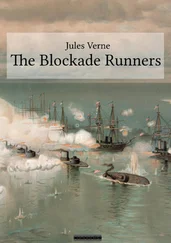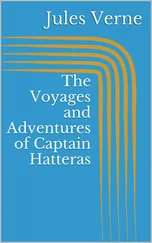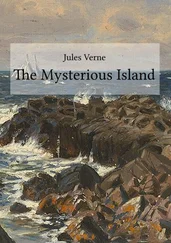“Do so,” said Shandon, “but allow me to tell you that you will not be the only proprietor of such a wreck. The Danish governor of the Isle of Disko–-“
“On the coast of Greenland,” continued the doctor, “possesses a mahogany table made from a trunk fished up under the same circumstances. I know it, but I don’t envy him his table, for if it were not for the bother, I should have enough there for a whole bedroom.”
During the night, from Wednesday to Thursday, the wind blew with extreme violence, and driftwood was seen more frequently. Nearing the coast offered many dangers at an epoch in which icebergs were so numerous; the commander caused some of the sails to be furled, and the Forward glided away under her foresail and foremast only. The thermometer sank below freezing-point. Shandon distributed suitable clothing to the crew, a woollen jacket and trousers, a flannel shirt, wadmel stockings, the same as those the Norwegian country-people wear, and a pair of perfectly waterproof sea-boots. As to the captain, he contented himself with his natural fur, and appeared little sensible to the change in the temperature; he had, no doubt, gone through more than one trial of this kind, and besides, a Dane had no right to be difficult. He was seen very little, as he kept himself concealed in the darkest parts of the vessel.
Towards evening the coast of Greenland peeped out through an opening in the fog. The doctor, armed with his glass, could distinguish for an instant a line of peaks, ridged with large blocks of ice; but the fog closed rapidly on this vision, like the curtain of a theatre falling in the most interesting moment of the piece.
On the morning of the 20th of April the Forward was in sight of an iceberg a hundred and fifty feet high, stranded there from time immemorial; the thaws had taken no effect on it, and had respected its strange forms. Snow saw it; James Ross took an exact sketch of it in 1829; and in 1851 the French lieutenant Bellot saw it from the deck of the Prince Albert . Of course the doctor wished to keep a memento of the celebrated mountain, and made a clever sketch of it. It is not surprising that such masses should be stranded and adhere to the land, for to each foot above water they have two feet below, giving, therefore, to this one about eighty fathoms of depth.
At last, under a temperature which at noon was only 12 degrees, under a snowy and foggy sky, Cape Farewell was perceived. The Forward arrived on the day fixed; if it pleased the unknown captain to come and occupy his position in such diabolical weather he would have no cause to complain.
“There you are, then,” said the doctor to himself, “cape so celebrated and so well named! Many have cleared it like us who were destined never to see it again. Is it, then, an eternal adieu said to one’s European friends? You have all passed it. Frobisher, Knight, Barlow, Vaughan, Scroggs, Barentz, Hudson, Blosseville, Franklin, Crozier, Bellot, never to come back to your domestic hearth, and that cape has been really for you the cape of adieus.”
It was about the year 970 that some navigators left Iceland and discovered Greenland. Sebastian Cabot forced his way as far as latitude 56 degrees in 1498. Gaspard and Michel Cotreal, in 1500 and 1502, went as far north as 60 degrees; and Martin Frobisher, in 1576, arrived as far as the bay that bears his name. To John Davis belongs the honour of having discovered the Straits in 1585; and two years later, in a third voyage, that bold navigator and great whaler reached the sixty-third parallel, twenty-seven degrees from the Pole.
Barentz in 1596, Weymouth in 1602, James Hall in 1605 and 1607, Hudson, whose name was given to that vast bay which hollows out so profoundly the continent of America, James Poole, in 1611, advanced far into the Strait in search of that NorthWest passage the discovery of which would have considerably shortened the track of communication between the two worlds. Baffin, in 1616, found the Straits of Lancaster in the sea that bears his own name; he was followed, in 1619, by James Munk, and in 1719 by Knight, Barlow, Vaughan, and Scroggs, of whom no news has ever been heard. In 1776 Lieutenant Pickersgill, sent out to meet Captain Cook, who tried to go up Behring’s Straits, reached the sixty-eighth degree; the following year Young, for the same purpose, went as far north as Woman’s Island.
Afterwards came Captain James Ross, who, in 1818, rounded the coasts of Baffin’s Sea, and corrected the hydrographic errors of his predecessors. Lastly, in 1819 and 1820, the celebrated Parry passed through Lancaster Straits, and penetrated, in spite of unnumbered difficulties, as far as Melville Island, and won the prize of 5,000 pounds promised by Act of Parliament to the English sailors who would reach the hundred and seventeenth meridian by a higher latitude than the seventy-seventh parallel.
In 1826 Beechey touched Chamisso Island; James Ross wintered from 1829 to 1833 in Prince Regent Straits, and amongst other important works discovered the magnetic pole. During this time Franklin, by an overland route, traversed the septentrional coasts of America from the River Mackenzie to Turnagain Point. Captain Back followed in his steps from 1823 to 1835, and these explorations were completed in 1839 by Messrs. Dease and Simpson and Dr. Rae.
Lastly, Sir John Franklin, wishing to discover the NorthWest passage, left England in 1845 on board the Erebus and the Terror ; he penetrated into Baffin’s Sea, and since his passage across Disko Island no news had been heard of his expedition.
That disappearance determined the numerous investigations which have brought about the discovery of the passage, and the survey of these Polar continents, with such indented coast lines. The most daring English, French, and American sailors made voyages towards these terrible countries, and, thanks to their efforts, the maps of that country, so difficult to make, figured in the list of the Royal Geographical Society of London. The curious history of these countries was thus presented to the doctor’s imagination as he leaned on the rail, and followed with his eyes the long track left by the brig. Thoughts of the bold navigators weighed upon his mind, and he fancied he could perceive under the frozen arches of the icebergs the pale ghosts of those who were no more.
CHAPTER VII
DAVIS’S STRAITS
Table of Contents
During that day the Forward cut out an easy road amongst the half-broken ice; the wind was good, but the temperature very low; the currents of air blowing across the icefields brought with them their penetrating cold. The night required the severest attention; the floating icebergs drew together in that narrow pass; a hundred at once were often counted on the horizon; they broke off from the elevated coasts under the teeth of the grinding waves and the influence of the spring season, in order to go and melt or to be swallowed up in the depths of the ocean. Long rafts of wood, with which it was necessary to escape collision, kept the crew on the alert; the crow’s nest was put in its place on the mizenmast; it consisted of a cask, in which the ice-master was partly hidden to protect him from the cold winds while he kept watch over the sea and the icebergs in view, and from which he signalled danger and sometimes gave orders to the crew. The nights were short; the sun had reappeared since the 31st of January in consequence of the refraction, and seemed to get higher and higher above the horizon. But the snow impeded the view, and if it did not cause complete obscurity it rendered navigation laborious.
On the 21st of April Desolation Cape appeared in the midst of thick mists; the crew were tired out with the constant strain on their energies rendered necessary ever since they had got amongst the icebergs; the sailors had not had a minute’s rest; it was soon necessary to have recourse to steam to cut a way through the heaped-up blocks. The doctor and Johnson were talking together on the stern, whilst Shandon was snatching a few hours’ sleep in his cabin. Clawbonny was getting information from the old sailor, whose numerous voyages had given him an interesting and sensible education. The doctor felt much friendship for him, and the boatswain repaid it with interest.
Читать дальше












